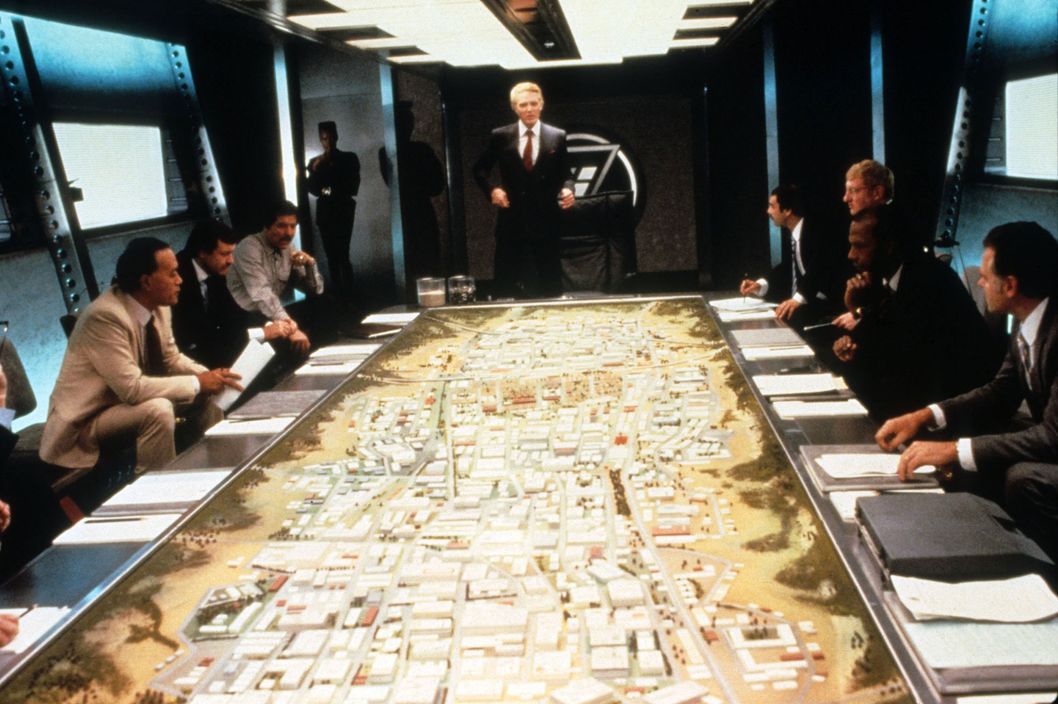Unfortunately the econ/finance crowd didn't deliver and I forgot the link.
Now corrected.
Thanks be to The Onion for the insightful interrogatory:
Can Anyone Truly Be Said To ‘Own’ The Complete James Bond Collection?
From Vulture, Nov. 9, 2012:
Ask an Economist: Which Bond Villain Plan Would Have Worked (and Which Not)?

A VIEW TO A KILL US / BR 1985 CHRISTOPHER WALKEN rear center
While the bad guy in Skyfall is obsessed primarily with revenge and humiliation, many of James Bond’s chief adversaries over the years have wanted something more simple and tangible: cash money. The Bond villain is often deranged and grandiose, sure, but he (or she) is also capable of hatching elaborate plans to increase their bottom line, often by secretly manipulating the world’s economic systems (sometimes with the aid of a clandestine nuclear weapon or two). So, could they have succeeded? If James Bond hadn’t foiled these plots, could these Bond villains have fulfilled their dreams of financial glory? We looked through their schemes, and asked Jean-Jacques Dethier, a development economist at the World Bank (and a lifelong Bond fan), what he thought.
Goldfinger
Plot: Gold tycoon Auric Goldfinger’s (Gert Frobe) plan is quite simple: He wants to attack the U.S. Bullion Depository in Fort Knox and detonate an atomic bomb, thus irradiating the gold stored there, rendering it worthless for decades. This will in turn increase the value of Goldfinger’s own gold and cause economic chaos in the Western world.
Plausibility: “This looks plausible to me,” says Dethier. “If you irradiate the gold, you can’t touch it — which will effectively reduce the gold supply, at a time when the United States currency was still on the gold standard.” However, there is one potential problem — the vast majority of the gold in the U.S. wasn’t in Fort Knox — it was (and remains) in the basement of the Federal Reserve Bank of New York, in downtown Manhattan. (But most of the gold in New York belongs to other nations, so Goldfinger’s evil plan is still fairly solid.)
Live and Let Die
Plot: Caribbean dictator/drug lord Dr. Kananga (Yaphet Kotto) is practically enslaving the poppy farmers of his nation, and plans to distribute heroin for free through his chain of U.S. restaurants, which he expects will simultaneously put his competitors (such as the Mafia) out of business and also create an America full of addicts. Then, faced with huge demand and no competitors, he will start charging high prices for his heroin.
Plausibility: “This is a bit harebrained,” says Dethier. “First of all, I think you can’t just grow opium poppies anywhere, which is why Afghanistan is considered such a high value location.” Additionally, he notes, it’d be almost impossible to eliminate competitors by monopolizing one drug, since they can still produce and distribute other drugs, such as cocaine and marijuana.
A View to a Kill
Plot: Max Zorin (Christopher Walken) wants to secretly trigger a massive earthquake that will destroy Silicon Valley. This will then allow him and his investor allies to monopolize the microchip manufacturing market.
...MORE
Plausibility: “As far as I know, microchips aren’t actually manufactured in Silicon Valley,” says Dethier. “They’re made all over the world, in China and other places, though the guys who commission the work may be in Silicon Valley.” Therefore, while taking out Silicon Valley would obviously be cataclysmic for the tech industry, he notes, it also wouldn’t entirely remove your competitors, and wouldn’t ultimately affect manufacturing that much....